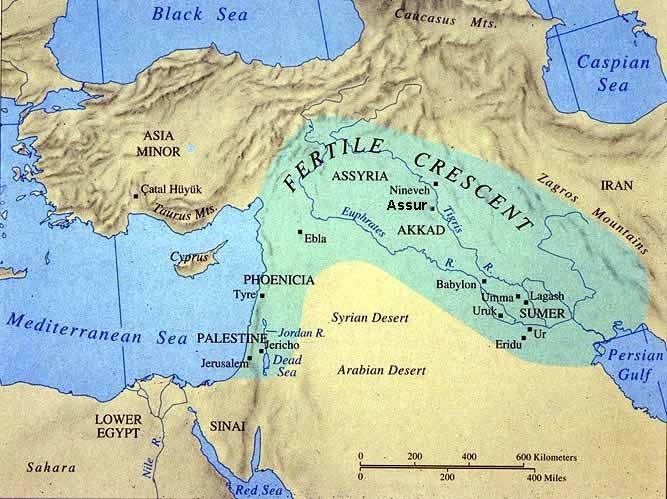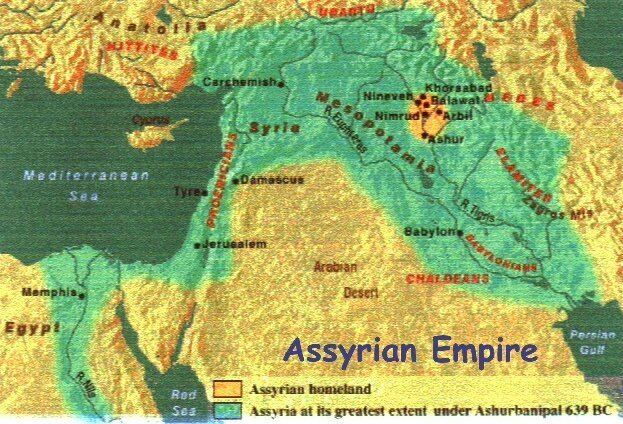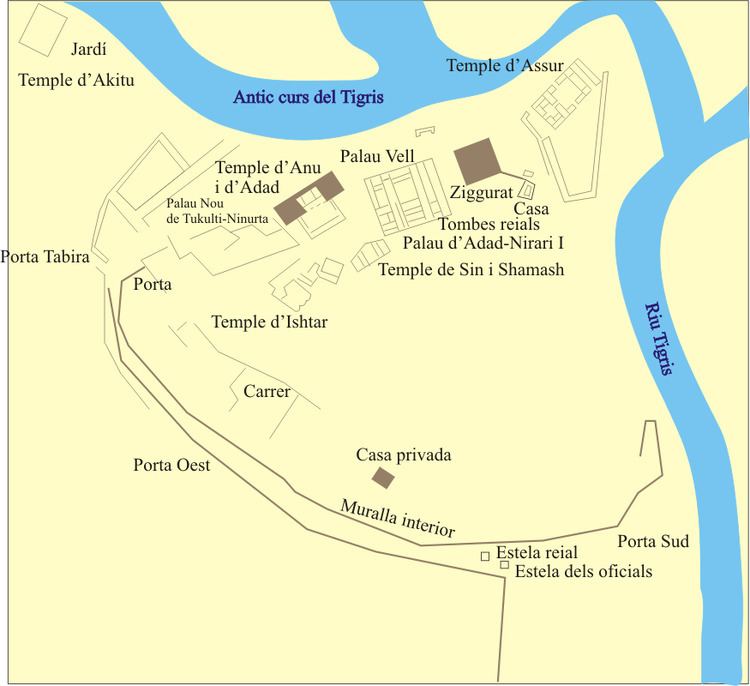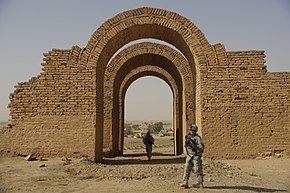Type Settlement Abandoned 14th century AD Local time Monday 7:28 AM | Founded Approximately 2500 BC | |
 | ||
Public access Inaccessible (in a war zone) Weather 7°C, Wind N at 8 km/h, 82% Humidity | ||
Ashur or assur
Aššur (Akkadian; Syriac: ܐܫܘܪ 'Āshūr; Persian: آشور: Āshūr; Hebrew: אַשּׁוּר Aššûr, Arabic: اشور: Āshūr, Kurdish Asûr), also known as Ashur and Qal'at Sherqat, was an Assyrian city, capital of the Old Assyrian Empire (2025–1750 BC), Middle Assyrian Empire (1365–1050 BC), and for a time, the Neo-Assyrian Empire (911–608 BC). The remains of the city are situated on the western bank of the Tigris River, north of the confluence with the tributary Little Zab River, in modern-day Iraq, more precisely in the Al-Shirqat District in the Saladin Governorate.
Contents
- Ashur or assur
- History of research
- Name
- Early Bronze Age
- Old and Middle Assyria
- Neo Assyrian Empire
- Achaemenid Empire
- Parthian Empire
- Threats to Assur
- References

Occupation of the city itself continued for approximately 4000 years, dating from the mid-3rd millennium BC (c. 2600 BC) to the mid 14th century AD, when its still indigenous Assyrian ( and by then Christian) population was massacred by Timur. The site is a World Heritage Site, being added to the list of sites in danger in 2003, following the conflict that erupted following the US-led invasion and as a result of a proposed dam which would flood some of the site. It lies 65 km (40 mi) south of the site of Nimrud and 100 km (60 mi) south of Nineveh.

History of research

Exploration of the site of Assur began in 1898 by German archaeologists. Excavations began in 1900 by Friedrich Delitzsch, and were continued in 1903–1913 by a team from the German Oriental Society led initially by Robert Koldewey and later by Walter Andrae. More than 16,000 tablets with cuneiform texts were discovered. Many of the objects found made their way to the Pergamon Museum in Berlin.

More recently, Ashur was excavated by B. Hrouda for the University of Munich and the Bavarian Ministry of Culture in 1990. During the same period, in 1988 and 1989, the site was being worked by R. Dittmann on behalf of the German Research Foundation.
Name
Aššur is the name of the city, of the land ruled by the city, and of its tutelary deity from which the natives take their name, as did the entire nation of Assyria which encompassed what is today northern Iraq, north east Syria and south east Turkey. Today the Assyrians are still found throughout the Middle East, particularly in Iraq, Iran, Syria, Turkey, and the Diaspora in the western world. Assur (Assurayu) is also the origin of the names Syria and Syriac, these being originally Indo-European derivations of Assyria, and for many centuries applying only to Assyria and the Assyrians (see Etymology of Syria) before also being applied to the Levant and its inhabitants by the Seleucid Empire in the 3rd century BC.
Early Bronze Age
Archaeology reveals the site of the city was occupied by the middle of the 3rd millennium BC. This was still the Sumerian period, before Assyria emerged in the 25th to 21st century BC. The oldest remains of the city were discovered in the foundations of the Ishtar temple, as well as at the Old Palace. In the subsequent period, the city was ruled by kings from the Akkadian Empire. During the Third Dynasty of Ur, the city was ruled by Assyrian governors subject to the Sumerians.
Old and Middle Assyria
By the time the Neo-Sumerian Ur-III dynasty collapsed at the hands of the Elamites around the end of the 21st century BC according to the Middle Chronology and mid-20th century according to the Short Chronology following increasing raids by Gutians and Amorites. The native Akkadian speaking Assyrian kings were now free while Sumer fell under the yoke of the Amorites. The Assyrian king Ushpia who reigned around the 21st century BC is credited with dedicating the first temple of the god Ashur in his home city, although this comes from a later inscription from Shalmaneser I in the 13th century. The temple likely dates to the original settlement of the site when the people of Ashur established their nation under the patronage of the city's god. Soon after in around 2000 BC, Puzur-Ashur I founded a new dynasty, with his successors such as Ilushuma, Erishum I and Sargon I leaving inscriptions regarding the building of temples to Ashur, Adad and Ishtar in the city. Prosperity and independence produced the first significant fortifications in this period. As the region enjoyed relative peace and stability, trade between Mesopotamia and Anatolia increased, and the city of Ashur greatly benefited from its strategic location. Merchants would dispatch their merchandise via caravan into Anatolia and trade primarily at Assyrian colonies in Anatolia, the primary one being at Karum Kanesh (Kültepe).
With Shamshi-Adad I's (1813–1781 BC) capital at Assur, he magnified the city's power and influence beyond the Tigris river valley, establishing what some regard as the first Assyrian Empire. In this era, the Great Royal Palace was built, and the temple of Assur was expanded and enlarged with a ziggurat. However, this empire met its end when Hammurabi, the Amorite king of Babylon conquered and incorporated the city into his short lived empire following the death of Ishme-Dagan I around 1756 BC, while the next three Assyrian kings were viewed as vassals. Not long after, the native king Adasi expelled the Babylonians and Amorites from Assur and Assyria as a whole around 1720 BC, although little is known of his successors. Evidence of further building activity is known from a few centuries later, during the reign of a native king Puzur-Ashur III, when the city was refortified and the southern districts incorporated into the main city defenses. Temples to the moon god Sin (Nanna) and the sun god Shamash were built and dedicated through the 15th century BC. The city was subsequently subjugated by the king of Mitanni, Shaushtatar in the late 15th century, taking the gold and silver doors of the temple to his capital, Washukani, as spoils.
Ashur-uballit I emulated his ancestor Adasi and overthrew the Mitanni empire in 1365 BC. The Assyrians reaped the benefits of this triumph by taking control of the eastern portion of the Mitanni Empire, and later also annexing Hittite, Babylonian, Amorite and Hurrian territory. The following centuries witnessed the restoration of the old temples and palaces of Assur, and the city once more became the throne of a magnanimous empire from 1365 BC to 1076 BC. Tukulti-Ninurta I (1244–1208 BC) also constructed a new temple to the goddess Ishtar. The Anu-Adad temple was established later during the reign of Tiglath-Pileser I (1115–1075 BC). The walled area of the city in the Middle Assyrian period made up some 1.2 square kilometres (300 acres).
Neo-Assyrian Empire
In the Neo-Assyrian Empire (912–605 BC), the royal residence was transferred to other Assyrian cities. Ashur-nasir-pal II (884–859 BC) moved the capital from Assur to Kalhu (Calah/Nimrud) following a series of successful campaigns and produced some of the greatest artworks in the form of colossal lamassu statues and low-relief depictions of the royal court as well as battles. With the reign of Sargon II (722–705 BC), a new capital began to rise. Dur-Sharrukin (Fortress of Sargon) on a scale set to surpass that of Ashurnasirpal's. However, he died in battle and his son and successor Sennacherib (705–682 BC) abandoned the city, choosing to magnify Niniveh as his royal capital. However, the city of Ashur remained the religious center of the empire and continued to be revered as the holy crown of the empire, due to its temple of the national god Ashur. In the reign of Sennacherib (705–682 BC), the House of the New Year, Akitu, was built, and the festivities celebrated in the city. Many of the kings were also buried beneath the Old Palace while some queens were buried in the other capitals such as the wife of Sargon, Ataliya. The city was sacked and largely destroyed during the conquest of Assyria by the Medes, Babylonians, Scythians and Persians in 612 BC.
Achaemenid Empire
After the Medes were overthrown by the Persians as the dominant force in ancient Iran, Assyria was ruled by the Persian Achaemenid Empire (as Athura) from 549 BC to 330 BC (see Achaemenid Assyria). The Assyrians of Mada (Media) and Athura (Assyria) had been responsible for gold and glazing works of the palace and for providing Lebanese cedar timber, respectively. The city and region of Ashur had once more gained a degree of militaristic and economic strength. Along with the Assyrians in Mada, a revolt took place in 520 BC but ultimately failed. Assyria seems to have recovered dramatically, and flourished during this period. It became a major agricultural and administrative centre of the Achaemenid Empire, and its soldiers were a mainstay of the Persian Army.
Parthian Empire
The city was part of a further Assyrian revival some centuries later, during the Parthian Empire period, particularly between 150 BC and 270 AD, the city became an important administrative centre of Parthian ruled Assyria (Assuristan), and some Assyriologists such as Simo Parpola and Patricia Crone have suggested it may have had outright independence between the 2nd century BC and 3rd century AD. Other Assyrian polities such as Beth Garmai, Beth Nuhadra, Osroene and Adiabene also flourished due to the fact that the Parthians exercised only lose or intermittent control of Assyria. New administrative buildings were erected to the north of the old city, and a palace to the south. The old temple dedicated to the national god of the Assyrians Assur (Ashur) was also rebuilt, as were temples to other Assyrian gods.
Assyrian Eastern Aramaic inscriptions from the remains of Ashur have yielded insight into the Parthian-era city with Assyria having its own Aramaic Syriac script, which was the same in terms of grammar and syntax as that found at Edessa and elsewhere in the Neo-Assyrian state of Osroene.
German archaeologist Klaus Beyer published over 600 inscriptions from Mesopotamian towns and cities including Ashur, Dura-Europos, Hatra, Gaddala, Tikrit and Tur Abdin. Given that Christianity had begun to spread amongst the Assyrians throughout the Parthian era, the original Assyrian culture and religion persisted for some time alongside Assyrian Christianity, as proven by the inscriptions which included invocations to the gods Ashur, Nergal, Sin, Ishtar and Shamash, as well as the citizens mentioned in the inscriptions having compound names as was the tradition of the Mesopotamians. These personal names included ʾAssur-ḥēl (Ashur [is] my strength), ʾAssur-emar (Ashur decreed/commanded), ʾAssur-ntan (Ashur gave [a son]; compare with Esarhaddon) and ʾAssur-šma' (Ashur has heard).
Assyria briefly fell to the Roman Empire in 114AD, becoming the Roman province of Assyria before the Parthian empire with the help of Assyrian locals drove them out. The city again came under repeated attacks from the Roman incursions deep into Sasanian territory, sustaining heavy damage at the hands of Septimus Severus in 198 AD.
Shapur I captured and sacked the city in 257 AD after doing the same to Osroene, Adiabene, Beth Nuhadra, Beth Garmai and Hatra, incorporating Assyria into the Sassanid Empire. However the city remained and flourished with settlement by Assyrians continuing right up until the 14th century AD when Tamurlane conducted a massacre of the native Assyrian Christians. After that there are no traces of a settlement in the archaeological and numismatic record.
Threats to Assur
The site was put on UNESCO's List of World Heritage in danger in 2003, at which time the site was threatened by a looming large-scale dam project that would have submerged the ancient archaeological site. The dam project was put on hold shortly after the 2003 invasion of Iraq.
The territory around the ancient site was occupied by the Islamic State of Iraq and the Levant (ISIL) in 2015. Since ISIL had destroyed a number of ancient Assyrian sites, including the cities of Hatra, Khorsabad, and Nimrud, fears rose that Assur would be destroyed too. According to some sources, the citadel of Assur was blown up in May 2015 using improvised explosive devices.
